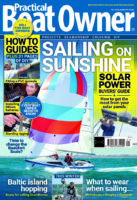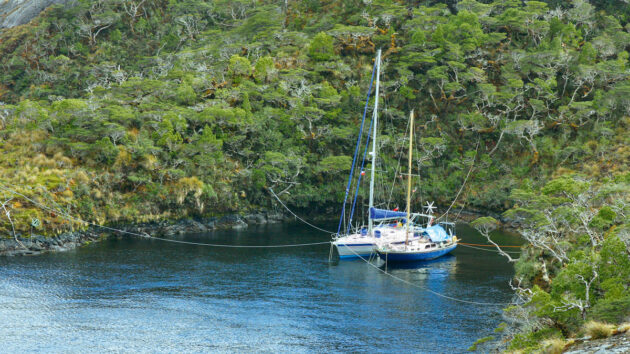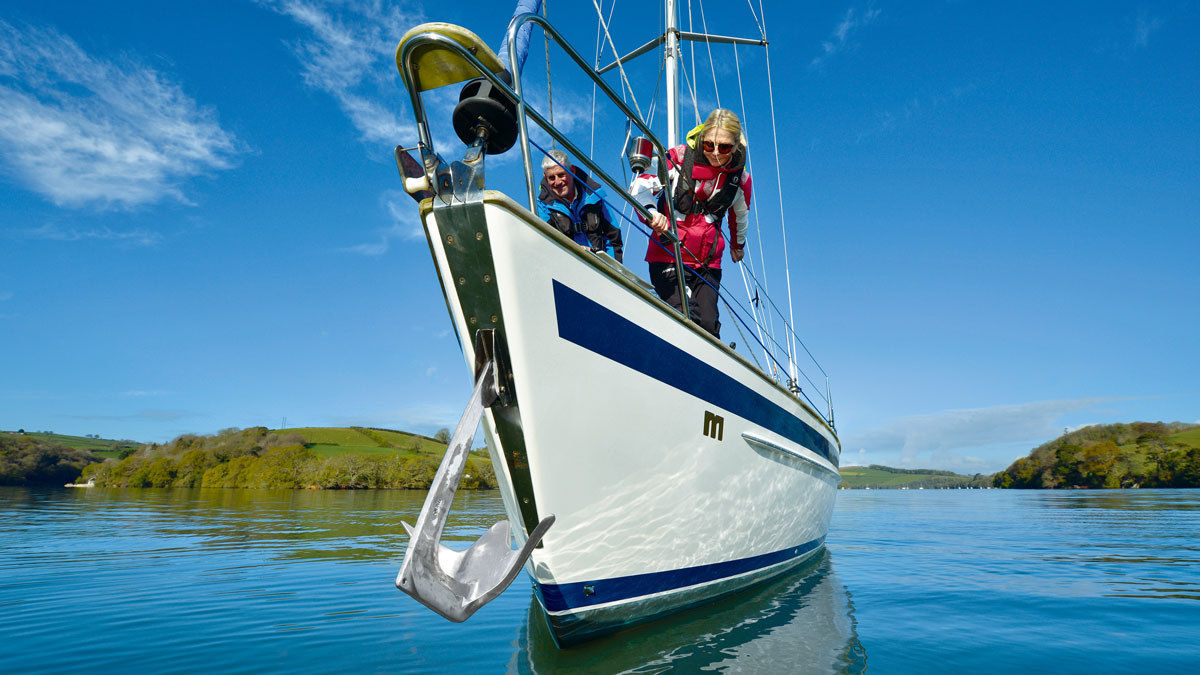Genevieve Leaper explains why, in some circumstances, using a shore line to keep the boat secure makes perfect sense
Sailing in Patagonia was one of the most memorable experiences of my life, for wilderness, wildlife and extreme weather, not to mention meeting my partner Aleko, who was sailing his Nicholson 32, Beduin.
One of the biggest surprises in this wild and windy region was to find the anchorages as snug and sheltered as they were beautiful.
And in almost every one, we took lines to the shore when we anchored. This was a completely new technique to me, and it felt strange at first after a lifetime of swinging to an anchor.
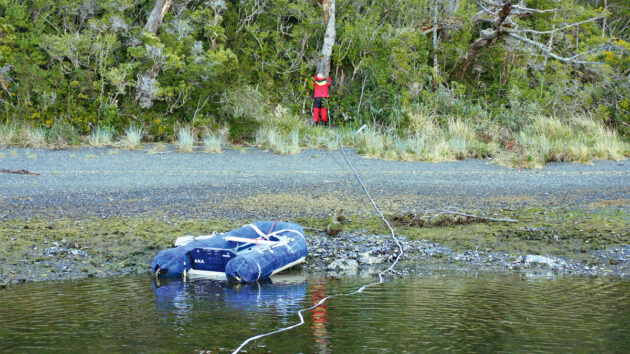
A very long bowline is the best knot to tie when securing the shore line, for easy release. Credit: Genevieve Leaper
But as it was my job to launch the dinghy and row ashore with a line while the skipper and mate were setting the anchor, tree-hugging soon became a normal part of the cruising routine.
When I came home, I couldn’t help noticing how many Scottish anchorages would benefit from more trees!
Aleko and I now mostly sail Beduin in the Aegean Sea, where we quite often use a shore line. It’s also common practice in various other popular cruising areas, such as the Baltic.
Why use a shore line?
So why would you use a shore line?
In Chile, it was mainly because we needed to anchor very close to the shore, the water being too deep further out in this mountainous region where thickly wooded hillsides fall steeply to the sea.
The shelter provided by the trees was an added benefit to tucking in close.
Even when the depth is suitable for anchoring in the middle of an inlet, many potentially delightful places simply don’t have enough swinging room.
I can think of a few Scottish anchorages that are fine at neap tides but not quite big enough at springs when a longer rode is required for high tide, but there is less water at low tide.
In these circumstances, a line to the shore keeping the boat in the central pool may be the answer.
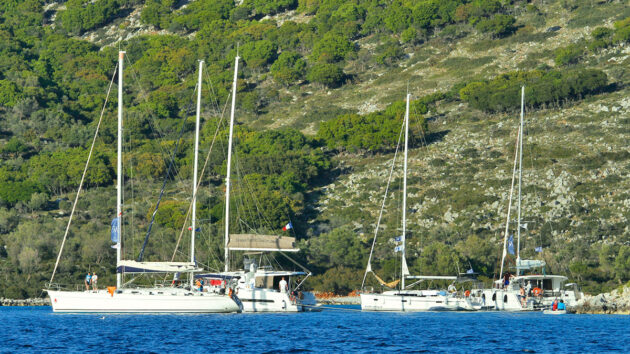
Boats can anchor closer together with shore lines to prevent swinging – here used by charter yachts in Greece. Credit: Genevieve Leaper
Equally, in a slightly larger space, using shore lines enables more boats to fit in, either lying parallel or rafted up. This is a standard practice for flotillas in Greece.
Cruising in the Aegean, we love exploring and finding anchorages that would never get a mention in the pilot book.
We have squeezed into many an unlikely spot with the help of a shore line or two and anchored off some unpromisingly rocky coastlines.
With crystal clear water, it’s possible to spy out any small patch of sand for the anchor, and a shore line preventing swinging reduces the risk of the chain getting caught around a rock.
Versatility of a shore line
Shore lines are not only useful in tight spaces. In a more open bay, the problem is more likely to be swell.
Often, you anchor comfortably with an offshore wind, which then drops in the night, allowing the boat to turn broadside to the swell.
Some of my favourite island anchorages are very exposed to swell and lovely boat that she is, Beduin really does roll!
A stern line to the shore, holding the bows into the waves, can make all the difference between soothing motion and a sleepless night.
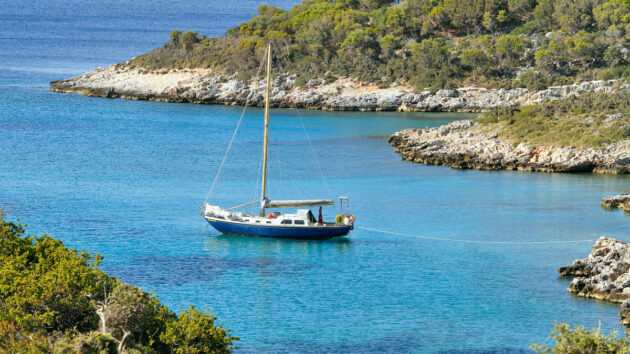
Using shore lines can mean a more stable night afloat, especially in exposed anchorages. Credit: Genevieve Leaper
Of course, a kedge anchor could be used to the same effect and will be more practical in some situations. Lines can also be taken from the bows.
Carefully positioned shore lines can provide extra security in bad weather or if holding is dubious.
We weathered one storm in Chile in a tiny inlet, the two boats secured together with a spider’s web of no less than seven lines.
An added bonus is being able to pull the dinghy along the line to get ashore in winds too strong to row against.
Rope and equipment
There are places where it’s normal to tie so close to the rocks that you can step off the bows. But generally to tie to anything on shore requires a long rope, much longer than normal mooring lines.
In Patagonia, two 100m lines are considered a minimum. It’s best to use floating rope to avoid snagging on underwater rocks or getting caught in the propeller.
This generally means polypropylene, though polyethylene also floats.
Braided ropes are the strongest, pleasant to handle and less prone to kink and knot than twisted ropes and are just a bit more expensive.
Polypropylene is lighter in weight and only slightly less strong than nylon.
However, it is less resistant to UV, so if stored permanently on deck, it’s a good idea to keep it covered.
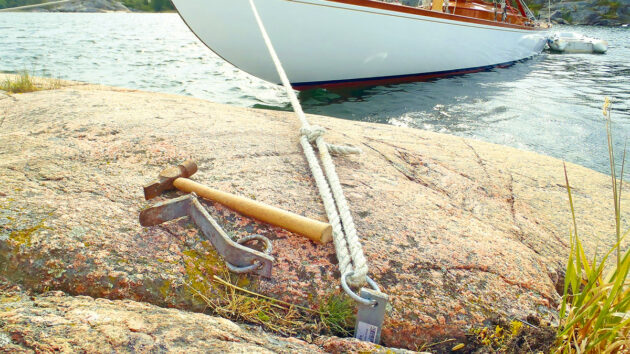
Rock wedges with eyes are essential Baltic cruising kit. Credit: Chris Beeson/Future
In the Mediterranean, or anywhere you expect to tie to rocks rather than trees, a loop of chain at the end of the line is fairly essential to avoid chafing on the rope.
We have about 3m of 6mm chain – long enough to go around a fair-sized rock but light enough to handle.
For occasional use, a length of tough, heavy rope is an alternative, but it should be tied tightly around the rock so there is no movement.
Rock wedges are often used in Sweden and Norway, where smooth, rounded granite offers no projections to tie around.
These are hammered into crevices and have a ring at the top for the line.
They can be difficult to remove afterwards, which means many are left available for the next boat.
There are also permanent mooring rings in many areas.
Storage
When shore lines are in frequent use, they need to be stored on deck and easily accessible.
My friends’ Ovni 435 had two large buckets by the mast and another line in a fish box in the cockpit.
Aleko, on the smaller boat, favoured large plastic laundry baskets on the aft deck where he could reach the lines from his paddleboard.
Back in Greece, where the shore line is less often used, we keep our 50m line in a plastic crate on the cabin top.
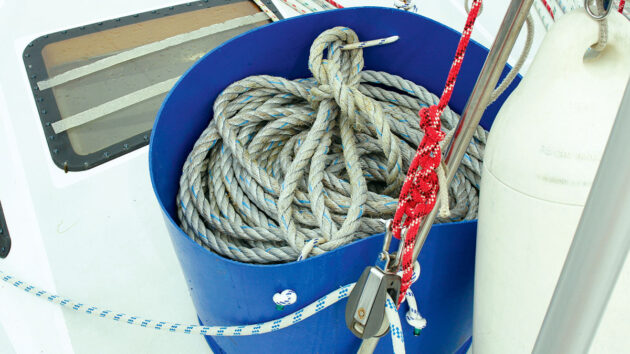
Half a plastic barrel makes a good storage container for 110m of polypropylene line. Credit: Genevieve Leaper
Obviously, any stowage container needs to drain easily, and the rope should be tied on at both ends.
We’re careful to flake the rope back in so it will run out easily next time. Other yachts cruising in Patagonia had a webbing line on a reel at the stern.
Aleko tried this, but found it impractical for the single-hander, not always running out freely as he paddled ashore.
Mooring procedure when using a shore line
Every situation is slightly different, but the general procedure is to anchor as normal, let out plenty of chain and reverse towards the shore.
Once happy with the position – and that the anchor is holding – it pays to take the line ashore as quickly as possible, so make sure the tender is ready to go;
it often helps to leave the boat’s engine in gear astern, too.
A paddleboard is ideal, especially if short-handed; it can be launched in seconds and is much easier than a dinghy if it’s necessary to land.
It’s easier with two people, one setting the line, the other ready to take in the slack and make it fast.
A sheet winch can be used, if necessary, to tension the line.
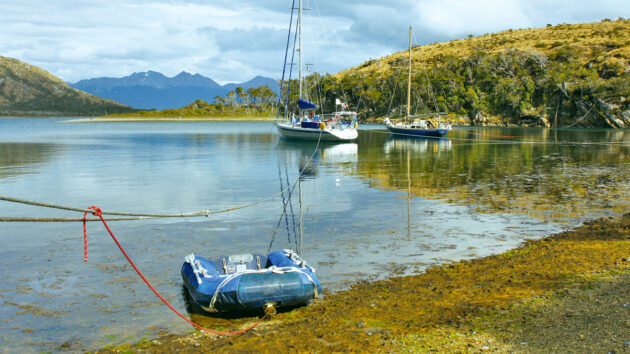
A shore line can be useful for pulling a dinghy along if the wind is too strong to row, or as a useful place to secure the dinghy when ashore. Credit: Genevieve Leaper
In practice, of course, there’s a little more to it, starting with choosing a suitable object to attach your line.
There is nothing better than a big sturdy tree trunk, and in Patagonia we were spoilt for choice – the main difficulty being getting to the chosen tree through the undergrowth.
Elsewhere, shoreside trees may be few and far between. Rocks are more variable than trees, so it can be harder to find one that the chain can easily be looped over but won’t slide off.
With the jagged limestone of many Aegean shores, there’s always something suitable, but other types of geology with smoother, rounded faces can be more challenging; hence the preference in the Baltic for rock wedges.
We try to pick a rock right on the water’s edge that is easily accessed by paddleboard, but this only works in areas with a minimal tidal range.
When tying to a tree above the shore, it’s a good idea to tie a very long bowline for easy release.
Aleko’s son, Leo, has cruised the west coast of Sweden in his Hallberg-Rassy. He explains how it’s done there, where most boats have a stern anchor winch.

In many parts of the Baltic, yachts moor bow-in to the rocks with a stern anchor. Credit: Leo Herold
“As newcomers to the area, we didn’t follow the local Swedish approach of throwing the stern anchor and heading full speed towards the rocks for someone to jump ashore and tie up. That felt too risky, as there are occasionally hidden rocks, and jumping off the bow can be tricky. Instead, we threw the stern anchor and approached the rocks slowly. Then we dropped the bow anchor with a bit of chain at a safe distance and used the paddleboard to take lines ashore. After that, we gradually pulled the boat into position and secured everything, sometimes allowing for a direct step onto the rocks.”
Retrieving the shore line should be quicker and easier than setting it, but you’ll probably need to slacken it for the crew to release at the shore end.
In a tight space, especially when it’s windy, think about how the boat will swing and be ready to take in the anchor chain.
Having released the shore line it’s usually best to keep the rope in the dinghy as you haul yourself back to the boat.
Alternatively, if there is more than one line, someone on board can haul in the rope while the shore crew goes to release the next.
Some thought may be required as to which line to release last.
Potential problems
Of course, there are drawbacks to attaching yourself to the land. Preventing the boat from swinging freely can be a problem if the wind direction changes.
It’s certainly not desirable to be held beam on to the wind. Taking the line from the stern to the bows may solve the problem.
A shore line does make it harder to leave in a hurry, though the line could be cut in an emergency.
Always be vigilant while paying out and taking in the line; there is nothing more embarrassing than tangling the prop with your own rope, and even with a floating line it can happen.
It’s important to consider other boats, and not obstruct access to the beach or prevent others from anchoring.
Lines should be visible and buoyed with a fender if not floating.
Uncommon in the UK
So why don’t we use shore lines more in the UK? The fact is that many areas are simply not suitable.
It’s only possible when anchoring close to shore, and there has to be something solid to attach to.
A shallow East Coast creek surrounded by acres of mud is clearly not the place. Naturally, it is more difficult to set up a shore line where there is a large tidal range.
Firstly, anchoring close inshore may not be an option, so even a 100m line might not be long enough.
Also, the tidal height is an extra factor to take into account when choosing an attachment point; it is somewhat inconvenient to find the end of your line 2m underwater when you want to leave!
Equally, the line that was easily accessible at high water might involve a long scramble over weedy rocks at low tide, or snag on those rocks as the tide falls.
However, it can be possible where the shore is steep; our rocky western coasts and islands being the most promising.
Aleko and I have used a shore line a couple of times in the Hebrides, most memorably to take advantage of an idyllic and sheltered spot at the head of a narrow inlet.
Most sailors in the UK will probably never anchor with a shore line, but 50m of floating rope, a short length of chain and something like a folding plastic crate for stowage will extend your options without taking up too much locker space.
Berthing a vessel: 2 clever ways with warps
In these days of fin keels, bow-thrusters and powerful engines, using warps for marina manoeuvres might seem an old-fashioned irrelevance…
How to free a fouled anchor
A fouled anchor doesn't have to mean losing costly ground tackle. If the conditions are right, you can save the…
The best boat anchor types for different types of cruising & their pros and cons
Rupert Holmes looks at the different anchor designs and how to choose the right one for your type of cruising
14 tips for single handed anchoring
Ben Meakins tries out some methods for dropping and recovering the anchor for singlehanded sailors in crowded anchorages
Want to read more articles like Rigging pile mooring pick-up lines?

A subscription to Practical Boat Owner magazine costs around 40% less than the cover price.
Print and digital editions are available through Magazines Direct – where you can also find the latest deals.
PBO is packed with information to help you get the most from boat ownership – whether sail or power.
-
-
-
- Take your DIY skills to the next level with trusted advice on boat maintenance and repairs
- Impartial, in-depth gear reviews
- Practical cruising tips for making the most of your time afloat
-
-
Follow us on Facebook, Instagram, TikTok and Twitter

